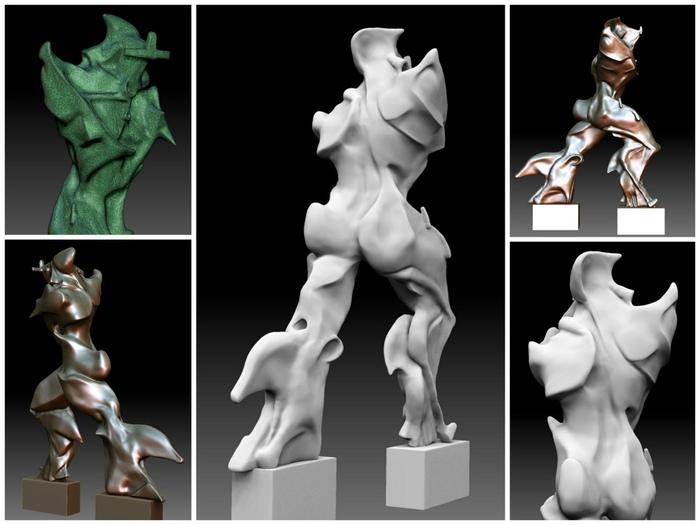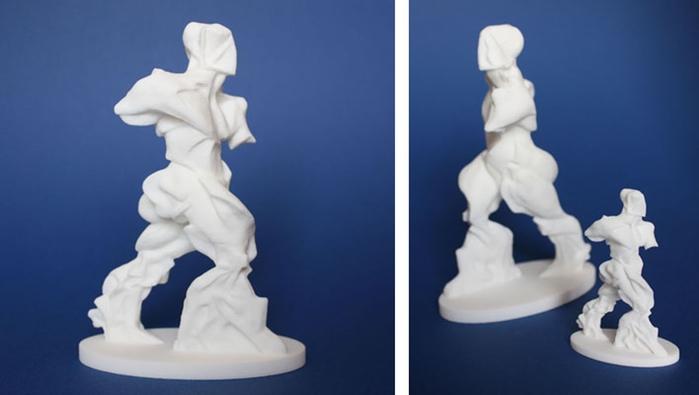 For a couple of months in late 1916 and early 1917, just a few months after his death in August 1916, many works of art by the Italian Futurist Umberto Boccioni were displayed in a memorial exhibition in Milan. Boccioni had been an influential artist, a true force of change in a world that was reluctant to embrace modern art. He and his fellow Futurists exalted all things modern, from trains, automobiles, and the factories that produced them, to modern weaponry and even war. The group’s manifesto was pretty overtly iconoclastic and their work in different ways sought to capture what they thought was the essence of modern life: motion, speed, dynamism.
For a couple of months in late 1916 and early 1917, just a few months after his death in August 1916, many works of art by the Italian Futurist Umberto Boccioni were displayed in a memorial exhibition in Milan. Boccioni had been an influential artist, a true force of change in a world that was reluctant to embrace modern art. He and his fellow Futurists exalted all things modern, from trains, automobiles, and the factories that produced them, to modern weaponry and even war. The group’s manifesto was pretty overtly iconoclastic and their work in different ways sought to capture what they thought was the essence of modern life: motion, speed, dynamism.
Several sculptural works, including four full-length striding figures, were included in that wintry retrospective exhibition. All of the striding figures were muscular, powerful male figures in motion, produced in plaster–and, in fact, Boccioni never cast a single one of them in bronze. After the exhibition closed, a disastrous incident of unexpected iconoclasm happened when the four sculptures were hacked to pieces by workmen who preferred to destroy the works rather than go to the trouble of moving them out of the courtyard where they had been displayed. Fortunately, Filippo Marinetti, an Italian poet and editor and the founder of the Futurist movement, noticed the broken sculptures and salvaged two works, one of the striding figures, Unique Forms of Continuity in Space, and another important Boccioni piece, Development of a Bottle in Space.
Those two sculptures were reassembled and photographs, sketches, and finished drawings of the other works were preserved. Later, several bronze casts of Unique Forms were produced and a few museums, including the Museum of Modern Art in New York, have bronze copies made well after Boccioni’s death.
One of the other striding figures, which Boccioni titled Spiral Expansion of Muscles in Movement (or Spiral Expansion of Muscles in Action), is being recreated by UK-based 3D designer, Matt Smith, who has launched a Kickstarter campaign to raise funds to assist with his effort. This is yet another example of how 3D scanning, modeling, and printing have the capacity to, in a sense, reclaim history–to fill in gaps and restore what would otherwise be lost to us.
Because Boccioni, like many artists before him, made multiple sketches and more finished drawings of his sculptures, working out compositions in 2D before moving to 3D, Smith can refer to the drawings by Boccioni and a handful of photographs as he recreates Spiral Expansion using digital sculpting techniques and, ultimately, 3D printing.

Matt Smith’s recreation of Boccioni’s lost work, Spiral Expansion of Muscles in Movement (or Action), 1913, plaster original.
Smith, who learned about Boccioni’s work and about the lost sculptures when he was an art student, hopes to exhibit his replica of Spiral Expansion at various galleries, with a premier exhibition in London. Smith understood, even as a young art student, how important were Boccioni’s contributions to the development of modern art. He explained why he undertook this project:
“I wanted to understand more about this unique sculpture, to study the work. As it no longer existed, that was going to be a challenge…I saw the possibility of piecing the fragments together and sharing what I learned with others. I believe I have found enough evidence, photo references, drawings, and research to help me recreate the work in 3D as the artist intended.“
Smith has critical experience that will lend itself to the production of an arguably more accurate replica of Spiral Expansion as he trained as a sculptor, working primarily in clay. From that hands-on experience with materials he moved on to modeling in 3D in the digital world, creating virtual objects that could be realized in the physical world. So, you might say, he’s seen all sides of 3D artistic production. In fact, his first 3D printed object was Boccioni’s Unique Forms of Continuity in Space, the work saved by Marinetti and later cast in bronze.
With his Kickstarter campaign still going through May 16th, Smith has raised £3,461 (as of the time of writing) of his £5,000 target and has 70 backers. He’s offering 3D printed replicas of his reconstruction of Spiral Expansion as well as images and downloads, including from his own body of work.
Indeed, one look at images of his work that Smith included on the Kickstarter page and it is clear why Boccioni’s art means so much to him. One work by Smith, in particular, an extremely angular figure resembling an angel, is evocative of Boccioni’s dynamic, facted forms and also possibly a covert reference to the famous ancient Greek sculpture of Winged Victory, that held particular significance for the Italian Futurists.
Smith’s photographs of his process of recreating Spiral Expansions alone are quite compelling. Further, the potential–as his project emphasizes–for 3D technology to connect us to otherwise inaccessible objects from our cultural and historical past has such profound and varied implications!
Let us know what you think of this use of 3D printing for artistic preservation in the Spiral Expansions forum thread over at 3DPB.com. Below is a video of the modeling process.
Podcast: Play in new window | Download
Subscribe to Our Email Newsletter
Stay up-to-date on all the latest news from the 3D printing industry and receive information and offers from third party vendors.
You May Also Like
3D Printed Heat Spreader Could Improve Efficiency of Electronics
The low-hanging fruit for decarbonization has long been improving the efficiency of existing systems, hence the justification for LED lights and ENERGY STAR certified appliances. While such minor moves are...
3D Printing News Unpeeled: Marine Gearboxes, 3D Printed Motors and $1.7 Million in Seed Funding
UK based Equipmake just released their Ampere-220 e-axle system. The system, which is meant for high performance electric cars, was similar to one released on the Ariel HIPERCAR. It has...
CEAD Unveils 36-Meter-Long 3D Printer for Abu Dhabi’s Al Seer Marine
CEAD, a Dutch original equipment manufacturer dedicated to large-format 3D printers, has unveiled what it claims to be the world’s largest robotic arm-based 3D printer. At 36 meters long and...
3D Printed Biocomposites Could Help Reduce Marine Plastic Pollution
Concerns about the impact of plastic litter and microplastics in the oceans are at the forefront of environmental study. For decades, the marine environment has suffered from the degradation of...





































